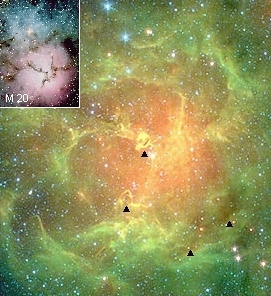
 A Stellar Nursery. The Trifid Nebula (M 20), located 5,400 light-years from us, in constellation Sagittarius, is an interesting example of how star-formation process is working, and is revealed there by NASA's Spitzer Space Telescope, this space telescope working in the infrared and able to pierce deep inside walls of dust and gas. Generally, most stars appear among large dust and gas clouds as shock waves are believed to be an important factor. Such waves may be traced back to supernovae events, for example as a first generation of stars are ending their lives blowing up, sending shock waves in the surrounding cloud. The Trifid Nebula is providing another cause to such events as a massive, 300,000 years old, central star, which was the first to condense there, is sending radiation and powerful solar winds all around. They are battering cold knots, or cores, where embryonic stars are forming. This is likely accelerating the infall of primitive material unto the nascing stars. About 120 other smaller stars are of the same generation than the large, central star. Dust knots are pointing to by black arrows as the bright yellow lanes of the picture by the Spitzer telescope are matching the dark ones of the Trifid Nebula seen in the visible (inset). picture site 'Amateur Astronomy' based on pictures NASA/JPL-Caltech/J.Rho(SSC/Caltech)
A Stellar Nursery. The Trifid Nebula (M 20), located 5,400 light-years from us, in constellation Sagittarius, is an interesting example of how star-formation process is working, and is revealed there by NASA's Spitzer Space Telescope, this space telescope working in the infrared and able to pierce deep inside walls of dust and gas. Generally, most stars appear among large dust and gas clouds as shock waves are believed to be an important factor. Such waves may be traced back to supernovae events, for example as a first generation of stars are ending their lives blowing up, sending shock waves in the surrounding cloud. The Trifid Nebula is providing another cause to such events as a massive, 300,000 years old, central star, which was the first to condense there, is sending radiation and powerful solar winds all around. They are battering cold knots, or cores, where embryonic stars are forming. This is likely accelerating the infall of primitive material unto the nascing stars. About 120 other smaller stars are of the same generation than the large, central star. Dust knots are pointing to by black arrows as the bright yellow lanes of the picture by the Spitzer telescope are matching the dark ones of the Trifid Nebula seen in the visible (inset). picture site 'Amateur Astronomy' based on pictures NASA/JPL-Caltech/J.Rho(SSC/Caltech)
Website Manager: G. Guichard, site 'Amateur Astronomy,' http://stars5.6te.net. Page Editor: G. Guichard. last edited: 12/28/2010. contact us at ggwebsites@outlook.com

